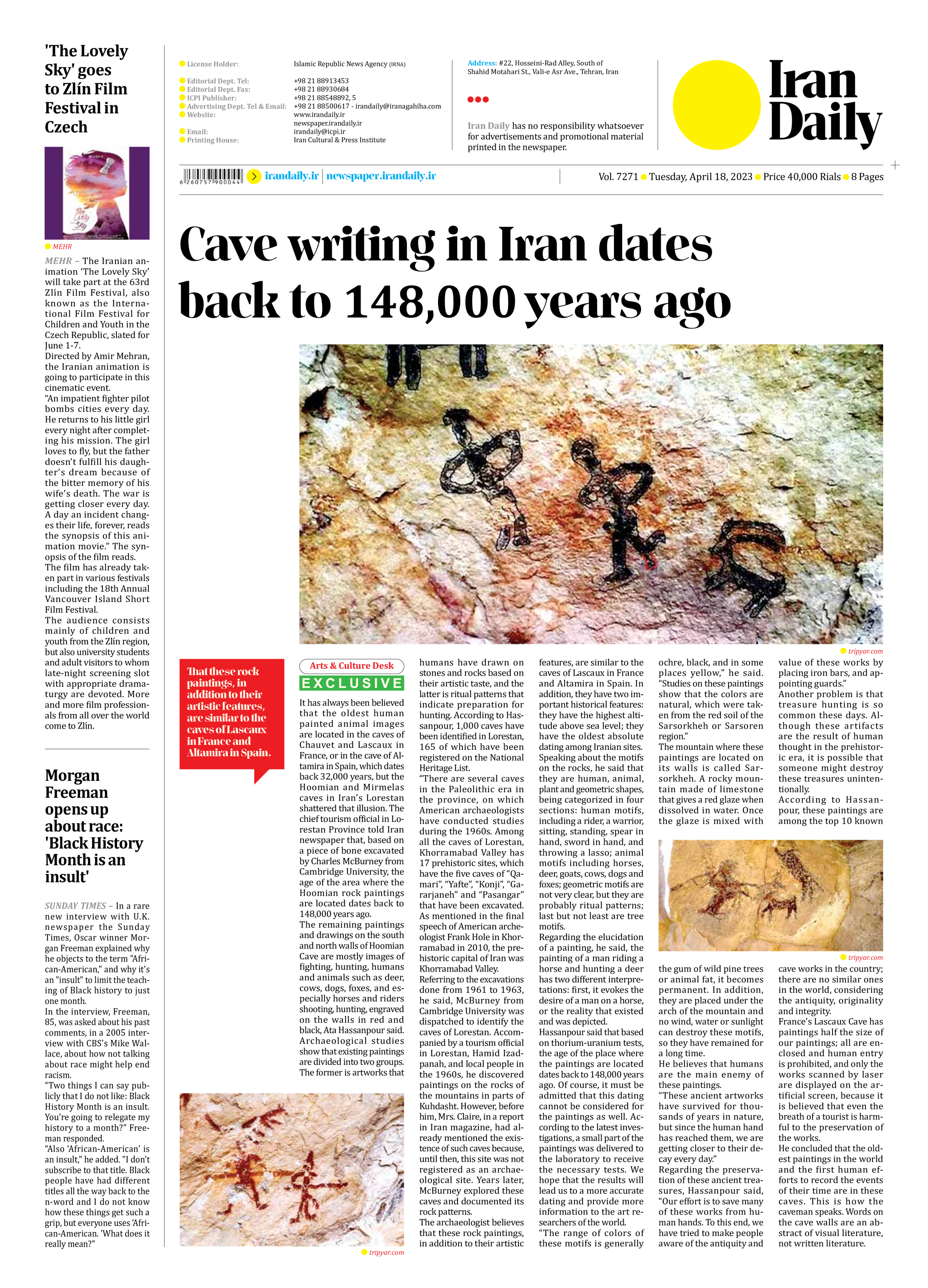
Cave writing in Iran dates back to 148,000 years ago
It has always been believed that the oldest human painted animal images are located in the caves of Chauvet and Lascaux in France, or in the cave of Altamira in Spain, which dates back 32,000 years, but the Hoomian and Mirmelas caves in Iran’s Lorestan shattered that illusion. The chief tourism official in Lorestan Province told Iran newspaper that, based on a piece of bone excavated by Charles McBurney from Cambridge University, the age of the area where the Hoomian rock paintings are located dates back to 148,000 years ago.
The remaining paintings and drawings on the south and north walls of Hoomian Cave are mostly images of fighting, hunting, humans and animals such as deer, cows, dogs, foxes, and especially horses and riders shooting, hunting, engraved on the walls in red and black, Ata Hassanpour said.
Archaeological studies show that existing paintings are divided into two groups. The former is artworks that humans have drawn on stones and rocks based on their artistic taste, and the latter is ritual patterns that indicate preparation for hunting. According to Hassanpour, 1,000 caves have been identified in Lorestan, 165 of which have been registered on the National Heritage List.
“There are several caves in the Paleolithic era in the province, on which American archaeologists have conducted studies during the 1960s. Among all the caves of Lorestan, Khorramabad Valley has 17 prehistoric sites, which have the five caves of “Qamari”, “Yafte”, “Konji”, “Gararjaneh” and “Pasangar” that have been excavated. As mentioned in the final speech of American archeologist Frank Hole in Khorramabad in 2010, the prehistoric capital of Iran was Khorramabad Valley.
Referring to the excavations done from 1961 to 1963, he said, McBurney from Cambridge University was dispatched to identify the caves of Lorestan. Accompanied by a tourism official in Lorestan, Hamid Izadpanah, and local people in the 1960s, he discovered paintings on the rocks of the mountains in parts of Kuhdasht. However, before him, Mrs. Claire, in a report in Iran magazine, had already mentioned the existence of such caves because, until then, this site was not registered as an archaeological site. Years later, McBurney explored these caves and documented its rock patterns.
The archaeologist believes that these rock paintings, in addition to their artistic features, are similar to the caves of Lascaux in France and Altamira in Spain. In addition, they have two important historical features: they have the highest altitude above sea level; they have the oldest absolute dating among Iranian sites.
Speaking about the motifs on the rocks, he said that they are human, animal, plant and geometric shapes, being categorized in four sections: human motifs, including a rider, a warrior, sitting, standing, spear in hand, sword in hand, and throwing a lasso; animal motifs including horses, deer, goats, cows, dogs and foxes; geometric motifs are not very clear, but they are probably ritual patterns; last but not least are tree motifs.
Regarding the elucidation of a painting, he said, the painting of a man riding a horse and hunting a deer has two different interpretations: first, it evokes the desire of a man on a horse, or the reality that existed and was depicted.
Hassanpour said that based on thorium-uranium tests, the age of the place where the paintings are located dates back to 148,000 years ago. Of course, it must be admitted that this dating cannot be considered for the paintings as well. According to the latest investigations, a small part of the paintings was delivered to the laboratory to receive the necessary tests. We hope that the results will lead us to a more accurate dating and provide more information to the art researchers of the world.
“The range of colors of these motifs is generally ochre, black, and in some places yellow,” he said. “Studies on these paintings show that the colors are natural, which were taken from the red soil of the Sarsorkheh or Sarsoren region.”
The mountain where these paintings are located on its walls is called Sarsorkheh. A rocky mountain made of limestone that gives a red glaze when dissolved in water. Once the glaze is mixed with the gum of wild pine trees or animal fat, it becomes permanent. In addition, they are placed under the arch of the mountain and no wind, water or sunlight can destroy these motifs, so they have remained for a long time.
He believes that humans are the main enemy of these paintings.
“These ancient artworks have survived for thousands of years in nature, but since the human hand has reached them, we are getting closer to their decay every day.”
Regarding the preservation of these ancient treasures, Hassanpour said, “Our effort is to save many of these works from human hands. To this end, we have tried to make people aware of the antiquity and value of these works by placing iron bars, and appointing guards.”
Another problem is that treasure hunting is so common these days. Although these artifacts are the result of human thought in the prehistoric era, it is possible that someone might destroy these treasures unintentionally.
According to Hassanpour, these paintings are among the top 10 known cave works in the country; there are no similar ones in the world, considering the antiquity, originality and integrity.
France’s Lascaux Cave has paintings half the size of our paintings; all are enclosed and human entry is prohibited, and only the works scanned by laser are displayed on the artificial screen, because it is believed that even the breath of a tourist is harmful to the preservation of the works.
He concluded that the oldest paintings in the world and the first human efforts to record the events of their time are in these caves. This is how the caveman speaks. Words on the cave walls are an abstract of visual literature, not written literature.







